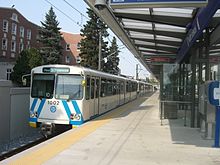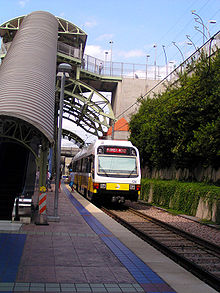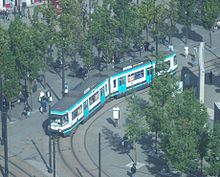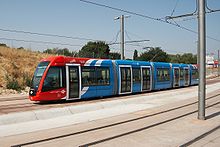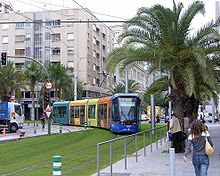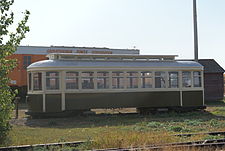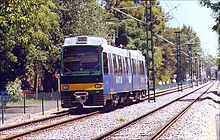- Light rail
-
For specific light rail systems, many of which use the words "light rail" as part of their name, see List of tram and light-rail transit systems.Edmonton Light Rail Transit in Edmonton, Alberta, Canada

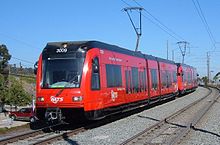 Two-car light rail train in San Diego, California
Two-car light rail train in San Diego, California
Light rail or light rail transit (LRT) is a form of urban rail public transportation that generally has a lower capacity and lower speed than heavy rail and metro systems, but higher capacity and higher speed than traditional street-running tram systems. The term is typically used to refer to rail systems with rapid transit-style features that usually use electric rail cars[1] operating mostly in private rights-of-way separated from other traffic but sometimes, if necessary, mixed with other traffic in city streets. If this is the case, then under the law of many countries such systems are legally tramways, although the vehicles which run on them are sometimes designated "supertrams". Modern light rail technology is flexible and adaptable, and whether any given system is considered a true rapid transit system or not depends on its characteristics.[2][3][4]
Definition of light rail
See also: Passenger rail terminologyThe term light rail was devised in 1972 by the U.S. Urban Mass Transportation Administration (UMTA) to describe new streetcar transformations that were taking place in Europe and the United States. In Germany the term Stadtbahn (to be distinguished from S-Bahn, which stands for Stadtschnellbahn) was used to describe the concept, and many in the UMTA (now called the Federal Transit Administration) wanted to adopt the direct translation, which is city rail (the Norwegian term, bybane, means the same). However, the UMTA finally adopted the term light rail instead.[5] Light in this context is used in the sense of "intended for light loads and fast movement", rather than referring to physical weight. The investment in infrastructure is also usually lighter than would be found for a heavy rail system.
Transportation Research Board (Transportation Systems Center) defined "light rail" in 1977 as: “a mode of urban transportation utilizing predominantly reserved but not necessarily grade-separated rights-of-way. Electrically propelled rail vehicles operate singly or in trains. LRT provides a wide range of passenger capabilities and performance characteristics at moderate costs.”
The American Public Transportation Association (APTA) in its Glossary of Transit Terminology defines light rail as: "An electric railway with a 'light volume' traffic capacity compared to heavy rail. Light rail may use shared or exclusive rights-of-way, high or low platform loading and multi-car trains or single cars."[6] However, some diesel powered transit calls itself light rail, such as the O-Train in Ottawa, Canada and River Line in New Jersey, United States, which use diesel multiple unit cars.
Light rail is similar to the British English term light railway, long used to distinguish railway operations carried out under a less rigorous set of regulation using lighter equipment at lower speeds from mainline railways. Light rail is a generic international English phrase for these types of rail systems, which means more or less the same thing throughout the Anglosphere.
The use of the generic term light rail avoids some serious incompatibilities in British and American English. The word tram, for instance, is generally understood in the UK and many former British colonies as a synonym for streetcar, but in North America it can instead refer to an aerial tramway.[7] (The usual British term for an aerial tramway is cable car, which in the U.S. usually refers to a ground-level car pulled along by subterranean cables.) The word trolley is often used as a synonym for streetcar in the United States, but is usually taken to mean a cart, particularly a shopping cart, in the UK and elsewhere.[8] Many North American transportation planners reserve streetcar for traditional vehicles that operate exclusively in mixed traffic on city streets, while they use light rail to refer to more modern vehicles operating mostly in exclusive rights of way, since they may operate both side-by-side targeted at different passenger groups.[9]
The difference between British English and American English terminology arose in the late nineteenth century when Americans adopted the term "street railway", rather than "tramway", with the vehicles being streetcars rather than trams. Some have suggested that the Americans' preference for the term "street railway" at that time was influenced by German emigrants to the United States[10] (who were more numerous than British immigrants in the industrialized Northeast), as it is the same as the German term for the mode, Straßenbahn (meaning "street railway"). A further difference arose because, while Britain abandoned all of its trams except Blackpool after World War II, seven major North American cities (Toronto, Boston, Philadelphia, San Francisco, Pittsburgh, Newark, and New Orleans) continued to operate large streetcar systems.[11] When these cities upgraded to new technology, they called it light rail to differentiate it from their existing streetcars since some continued to operate both the old and new systems. Since the 1980s, Portland, Oregon has built all three types of system: a high capacity light rail system in dedicated lanes and rights-of-way, a low capacity streetcar system integrated with street traffic, and an aerial tram system.
The opposite phrase heavy rail, used for higher capacity, higher speed systems also avoids some incompatibilities in terminology between British and American English, as for instance in comparing the London Underground to the New York Subway. Conventional rail technologies including high-speed, freight, commuter/regional, and metro/subway/elevated urban transit systems are considered to be "heavy rail". People movers and personal rapid transit are even "lighter," at least in terms of capacity. Monorail is a separate technology that has been more successful in specialized services than in a commuter transit role.
Categories of light rail
The most difficult distinction to draw is that between light rail and streetcar or tram systems. There is a significant amount of overlap between the technologies, many of the same vehicles can be used for either, and it is common to classify streetcars/trams as a subtype of light rail rather than as a distinct type of transportation. The two general versions are:
- The traditional type, where the tracks and trains run along the streets and share space with road traffic. Stops tend to be very frequent, but little effort is made to set up special stations. Because space is shared, the tracks are usually visually unobtrusive.
- A more modern variation, where the trains tend to run along their own right-of-way and are often separated from road traffic. Stops are generally less frequent, and the vehicles are often boarded from a platform. Tracks are highly visible, and in some cases significant effort is expended to keep traffic away through the use of special signaling, level crossings with gate arms or even a complete separation with non-level crossings. At the highest degree of separation, it can be difficult to draw the line between light rail and metros, as in the case of Wuppertal's Schwebebahn hanging rail system or London's Docklands Light Railway, which would likely not be considered "light" were it not for the contrast between it and the London Underground; many[who?] consider these not to be "light rail" lines but light metros. However, in Europe, the term light rail is increasingly being used to describe any rapid transit system with a fairly lower frequency or shorter trains compared to heavier mass rapid systems such as the London Underground or the Mass Rapid Transit in Singapore. For instance, the Putra LRT and Star LRT in Kuala Lumpur are often referred to as "light rail", despite being fully segregated mostly-elevated railways. In North America, such systems are not considered to be light rail.
Many light rail systems—even fairly old ones—have a combination of the two, with both on-road and off-road sections. In some countries (esp. in Europe), only the latter is described as light rail. In those places, trams running on mixed right-of-way are not regarded as light rail, but considered distinctly as streetcars or trams. However, the requirement for saying that a rail line is "separated" can be quite low—sometimes just with concrete "buttons" to discourage automobile drivers from getting onto the tracks.
There is a significant difference in cost between these different classes of light rail transit. The traditional style is often less expensive by a factor of two or more. Despite the increased cost, the more modern variation (which can be considered as "heavier" than old streetcar systems, even though it is called "light rail") is the dominant form of urban rail development in the United States.
Some systems, such as the AirTrain JFK in New York City and DLR in London and Kelana Jaya Line in Kuala Lumpur, Malaysia have dispensed with the need for an operator. The Vancouver SkyTrain was an early adopter of driverless vehicles, while the Toronto Scarborough rapid transit operates the same trains as Vancouver, but uses drivers. In most discussions and comparisons, these specialized systems are not considered to be light rail.
History
See also: History of Trams, Light rail in North America, Horsecar, Cable car (railway), and InterurbanMany original tram and streetcar systems in the United Kingdom, United States, and elsewhere, were decommissioned in the 1950s and onward as the popularity of the automobile increased. Britain abandoned its last tram system, except for Blackpool, by 1962.[13] Although some traditional trolley or tram systems still exist to this day, the term "light rail" has come to mean a different type of rail system. Modern light rail technology has primarily German origins, since an attempt by Boeing Vertol to introduce a new American light rail vehicle was a technical failure. After World War II, the Germans retained their streetcar networks and evolved them into model light rail systems (Stadtbahnen). Except for Hamburg, all large and most medium-sized German cities maintain light rail networks.[14]
The basic concepts of light rail were put forward by H. Dean Quinby in 1962 in an article in Traffic Quarterly called "Major Urban Corridor Facilities: A New Concept". Quinby distinguished this new concept in rail transportation from historic streetcar/tram systems as:
- Having the capacity to carry more passengers
- Appearing like a train, with more than one car connected together
- Having more doors to facilitate full utilization of the space
- Faster and quieter in operation
The term light rail transit (LRT) was introduced in North America in 1972 to describe this new concept of rail transportation.[15]
The first of the new light rail systems in North America began operation in 1978 when the Canadian city of Edmonton, Alberta adopted the German Siemens-Duewag U2 system, followed three years later by Calgary, Alberta and San Diego, California. The concept proved popular, and although Canada has few cities big enough for light rail, there are now at least 30 light rail systems in the United States.
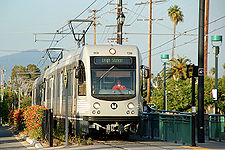 Los Angeles's mass transit expansion has been driven in large part by light rail
Los Angeles's mass transit expansion has been driven in large part by light rail
Britain began replacing its run-down local railways with light rail in the 1980s, starting with the Tyne and Wear Metro and followed by the Docklands Light Railway (DLR) in London. The historic term light railway was used because it dated from the British Light Railways Act 1896, although the technology used in the DLR system was at the high end of what Americans considered to be light rail. The trend to light rail in the United Kingdom was firmly established with the success of the Manchester Metrolink system in 1992.
Historically, the rail gauge has had considerable variations, with narrow gauge common in many early systems. However, most light rail systems are now standard gauge.[14] Older standard gauge vehicles could not negotiate sharp turns as easily as narrow gauge ones, but modern light rail systems achieve tighter turning radii by using articulated cars. An important advantage of standard gauge is that standard railway maintenance equipment can be used on it, rather than custom-built machinery. Using standard gauge also allows light rail vehicles to be moved around conveniently using the same tracks as freight railways. Another factor favoring standard gauge is that accessibility laws are making low-floor trams mandatory, and there is generally insufficient space for wheelchairs to move between the wheels in a narrow gauge layout.
Comparison to other rail transit modes
With its mix of right-of-way types and train control technologies, LRT offers the widest range of latitude of any rail system in the design, engineering, and operating practices. The challenge in designing light rail systems is to realize the potential of LRT to provide fast, comfortable service while avoiding the tendency to overdesign that results in excessive capital costs beyond what is necessary to meet the public's needs.[16]
Rapid rail transit
For more details on this topic, see Rapid transit.Light rail vehicles (LRVs) are distinguished from rapid rail transit (RRT) vehicles by their capability for operation in mixed traffic, generally resulting in a narrower car body and articulation in order to operate in a street traffic environment. With their large size, large turning radius, and often an electrified third rail, RRT vehicles cannot operate in the street. Since LRT systems can operate using existing streets, they can often avoid the cost of expensive grade-separated subway and elevated segments that would be required with RRT.
Streetcars or trams
For more details on this topic, see Tram.Conversely, LRVs generally outperform streetcars in terms of capacity and top-end speed, and almost all modern LRVs are capable of multiple-unit operation. Particularly on exclusive rights-of-way, LRVs can provide much higher speeds and passenger volumes than a streetcar. Thus a single-unit streetcar capable of only 70 kilometres per hour (43 mph) operating on a shared right of way is not generally considered “light rail”. The latest generation of LRVs is considerably larger and faster, typically of length of 29 metres (95 ft) with maximum speed around 105 kilometres per hour (65 mph).[17]
Heritage streetcar
For more details on this topic, see Heritage streetcar.A variation many cities consider is to use historic or replica cars on their streetcar systems instead of modern LRVs. A heritage streetcar may not have the capacity and speed of an LRV, but it will add to the ambiance and historic character of its location.
Typical rolling stock
The BART railcar in the following chart is not generally considered to be a "light rail" vehicle, and is only included for comparison purposes.
Type Rapid Transit Light Rail Tram / Streetcar Heritage Streetcar Manufacturer Rohr Siemens Skoda Gomaco Trolley Co. Model BART A-Car S70 10T Replica Birney Width 3.2 metres (10 ft) 2.7 metres (8.9 ft) 2.6 metres (8.53 ft) 2.62 metres (8.6 ft) Length 22.9 metres (75 ft) 27.7 metres (91 ft) (articulated) 20.13 metres (66.0 ft) 15.16 metres (49.7 ft) Capacity 150 max 220 max 157 max 88 max Top Speed 125 kilometres per hour (78 mph) 106 kilometres per hour (66 mph) 70 kilometres per hour (43 mph) 48 kilometres per hour (30 mph) Typical Consist 8-10 vehicles 1-4 vehicles 1 vehicle 1 vehicle Light metro
For more details on this topic, see Medium capacity system.A derivative of LRT is light rail rapid transit (LRRT), also referred to as Light Metro. Such railways are characterized by exclusive rights of way, advanced train control systems, short headway capability, and floor level boarding. These systems approach the passenger capacity of full metro systems, but can be cheaper to construct by using the ability of LRVs to turn tighter curves and climb steeper grades than standard RRT vehicles.
Interurbans
For more details on this topic, see Interurban.The term interurban (German Überland(strassen)bahn) mainly refers to rail-cars that run through the streets like ordinary streetcars (trams), but also between cities and/or towns, often through rural environments. In the period 1900-1930, interurbans were very common in the US, especially in the Midwest. Some of them, like the Red Devils, the J.G.Brill Bullets, and the Electroliners, were the high-speed railcars of their time, with an in-service speed of up to about 145 km/h (90 mph).
Train operation
For more details on this topic, see Automatic train operation.An important factor crucial to LRT is the train operator. Unlike rail rapid transit, which can travel unattended under control of automatic train operation (ATO), safe, high-quality LRT operation relies on a human operator as a key element. The reason that the operator is so important is because the train tracks often share the streets with automobiles, other vehicles, and pedestrians . If trains were fully automated on roads, nobody would be there to stop the train if a car pulled in front of it. Light rail trains are actually very sturdily built for passenger safety, and to reduce damage from impacts with cars. The philosophy of light rail is that a qualified person should be on each train to deal with emergencies[citation needed], and while that person is there, he or she might as well operate the train.
Floor height
For more details on this topic, see Low floor.The latest generation of LRVs has the advantage of partial or fully low-floor design, with the floor of the vehicles only 300 to 360 mm (11.8 to 14.2 in) above top of rail, a capability not found in either rapid rail transit vehicles or streetcars. This allows them to load passengers, including ones in wheelchairs, directly from low-rise platforms that are not much more than raised sidewalks. This satisfies requirements to provide access to disabled passengers without using expensive and delay-inducing wheelchair lifts, while at the same time making boarding faster and easier for other passengers as well.
Power sources
Overhead lines supply electricity to the vast majority of light rail systems. This avoids the danger of passengers stepping on an electrified third rail. The Docklands Light Railway uses an inverted third rail for its electrical power which allows the electrified rail to be covered and the power drawn from the underside. Trams in Bordeaux, France use a special third-rail configuration where the power is only switched on beneath the trams, making it safe on city streets. Several systems in Europe, as well as a few recently-opened systems in North America use diesel-powered trains.
Pros and cons of light rail
See also: Pros and cons of tram systemsAll transit service involves a trade-off between speed and frequency of stops. Services that stop frequently have lower overall speed and are therefore less attractive for longer trips but are more likely to go where the user wants. Light rail, monorail, and Bus Rapid Transit are all forms of rapid transit, which generally signifies high speed and widely-spaced stops. Trams are a form of local transit, making more frequent stops.
Tram and light-rail transit systems around the world
Main article: Tram and light-rail transit systemsAround the world there are many tram systems. Some date from the early 20th century, but many of the old systems were closed down in the mid-20th century, with the exceptions of many Eastern Europe countries. Even though many of the systems have closed down over the years there are still tram systems that have been operating much as they did when they were first built over a century ago. Some cities (such as Los Angeles and Jersey City) that once closed down their tram networks are now in the stages of reconstructing, or have rebuilt, some of their tramways. Most light rail services are currently committed to articulated vehicles like modern LRVs, i.e. trams, with the exception of large underground metro systems.
Capacity of light rail versus roads
One line of light rail has a theoretical capacity of up to 8 times more than one lane of freeway (not counting buses) during peak times. Roads have ultimate capacity limits that can be determined by traffic engineering. They usually experience a chaotic breakdown in flow and a dramatic drop in speed (colloquially known as a traffic jam) if they exceed about 2,000 vehicles per hour per lane (each car roughly two seconds behind another).[18] Since most people who drive to work or on business trips do so alone, studies show that the average car occupancy on many roads carrying commuters is only about 1.2 people per car during the high-demand rush hour periods of the day.[19] This combination of factors limits roads carrying only automobile commuters to a maximum observed capacity of about 2,400 passengers per hour per lane. The problem can be mitigated by using high-occupancy vehicle (HOV) lanes and introducing ride-sharing programs, but in most cases the solution adopted has been to add more lanes to the roads. Simple arithmetic shows that in order to carry 20,000 automobile commuters per hour per direction, a freeway must be at least 18 lanes wide.
By contrast, light rail vehicles can travel in multi-car trains carrying a theoretical ridership up to 20,000 passengers per hour in much narrower rights-of-way, not much more than two car lanes wide for a double track system.[20] They can often be run through existing city streets and parks, or placed in the medians of roads. If run in streets, trains are usually limited by city block lengths to about four 180-passenger vehicles (720 passengers). Operating on 2 minute headways using traffic signal progression, a well-designed two-track system can handle up to 30 trains per hour per track, achieving peak rates of over 20,000 passengers per hour in each direction. More advanced systems with separate rights-of-way using moving block signalling can exceed 25,000 passengers per hour per track.[21]
Most light rail systems in the United States are limited by demand rather than capacity (by and large, most North American LRT systems carry less than 4000 persons per hour per direction), but Boston and San Francisco light rail lines carry 9,600 and 13,100 passengers per hour per track during rush hour.[22] Elsewhere in North America, the Calgary C-Train, Toronto streetcar system, and Monterrey Metro have higher light rail ridership than Boston or San Francisco. Systems outside North America often have much higher passenger volumes. The Manila Light Rail Transit System is one of the highest capacity ones, having being upgraded in a series of expansions to handle 40,000 passengers per hour per direction, and having carried as many as 582,989 passengers in a single day on its Line #1.[23] It achieves this volume by running 4-car trains of up to 1350 passengers at a frequency of up to 30 trains per hour. It is important to note, however, that the Manila light rail system has full grade separation and as a result has many of the operating characteristics of a Metro system rather than a light rail system. 1350 passengers per train is more similar to heavy rail than light rail.
A bus line using its own lanes can have a capacity of 7,000 per hour (30 buses per direction, 120 passengers in articulated buses). Bus traffic is the traditional alternative to light rail, at least if very high capacity is not needed. Using buses, roads can get a high transit capacity. To have 30 buses per direction and hour, they must have priority in traffic lights and have their own lanes, as must trams to reach this density. Buses can go closer to each other than rail vehicles because of better braking capability. However, each bus vehicle requires a single driver, whereas a light rail train may have three to four cars of the same capacity in one train under the control of one driver, increasing labor costs of high- traffic BRT systems.
Integration of bicycles and light rail
Light rail lines have various policies on bicycles.[24] Some light rail lines fleets restrict bicycles during peak hours. Some light rail lines, for example in San Francisco, ban bicycles completely.[25]
Costs of light rail construction and operation
The cost of light rail construction varies widely, largely depending on the amount of tunneling and elevated structures required. A survey of North American light rail projects[26] shows that costs of most LRT systems range from $15 million per mile to over $100 million per mile. Seattle's new light rail system is by far the most expensive in the U.S. at $179 million per mile, since it includes extensive tunneling in poor soil conditions, elevated sections, and stations as deep as 180 feet (55 m) below ground level.[27] These result in costs more typical of subways or rapid transit systems than light rail. At the other end of the scale, four systems (Baltimore, MD; Camden, NJ; Sacramento, CA; and Salt Lake City, UT) incurred costs of less than $20 million per mile. Over the U.S. as a whole, excluding Seattle, new light rail construction costs average about $35 million per mile.[26]
By comparison, a freeway lane expansion typically costs $2.3 million per lane mile (a lane mile is a mile-long lane) for two directions.[28] Since a light rail track can carry up to 20,000 people per hour as compared with 2,000-2,200 vehicles per hour for one freeway lane,[29] light rail is comparable in construction cost to freeways on a per passenger-mile basis. For example, in Boston and San Francisco, light rail lines carry 9,600 and 13,100 passengers per hour, respectively, in the peak direction during rush hour.[22]
Combining highway expansion with LRT construction can save costs by doing both highway improvements and rail construction at the same time. As an example, Denver's T-REX (Transportation Expansion) project rebuilt interstate highways 25 and 225 and added a light-rail expansion for a total cost of $1.67 billion over five years.[30] The cost of 17 miles (27 km) of highway improvements and 19 miles (31 km) of double-track light rail worked out to $19.3 million per highway lane-mile and $27.6 million per LRT track-mile. The project came in under budget and 22 months ahead of schedule.[31]
LRT cost efficiency improves dramatically as ridership increases, as can be seen from the numbers above: the same rail line, with similar capital and operating costs, is far more efficient if it is carrying 20,000 people per hour than if it is carrying 2400. The Calgary, Alberta C-Train used many common light rail techniques to keep costs low, including minimizing underground and elevated trackage, sharing transit malls with buses, leasing rights-of-way from freight railroads, and combining LRT construction with freeway expansion. As a result, Calgary ranks toward the less expensive end of the scale with capital costs of around $24 million per mile.[32]
However, Calgary's LRT ridership is much higher than any comparable U.S. light rail system at 300,000 passengers per weekday, and as a result its efficiency of capital is also much higher. Its capital costs were ⅓ that of the San Diego Trolley, a comparably sized U.S. system built at the same time, while by 2009 its ridership was approximately three times as high. Thus, Calgary's capital cost per passenger was much lower than that of San Diego. Its operating cost per passenger was also much lower because of its higher ridership. A typical C-Train vehicle costs only $163 per hour to operate, and since it averages 600 passengers per operating hour,[33] Calgary Transit estimates that its LRT operating costs are only 27 cents per ride, versus $1.50 per ride on its buses.[32]
Variations
Trams operating on mainline railways
See also: Karlsruhe modelAround Karlsruhe, Kassel and Saarbrücken in Germany, dual-voltage light rail trains partly use mainline railroad tracks, sharing these tracks with heavy-rail trains. In the Netherlands, this concept was first applied on the RijnGouweLijn. This allows commuters to ride directly into the city centre, rather than taking a mainline train only as far as a central station and then having change to a tram. In France similar tram-trains are planned for Paris, Mulhouse and Strasbourg; further projects exist.
Some of the issues involved in such schemes are:
- Compatibility of the safety systems
- Power supply of the track in relation to the power used by the vehicles (frequently different voltages, rarely third rail vs overhead wires)
- Width of the vehicles in relation to the position of the platforms
- Height of the platforms
There is a history of what would now be considered light-rail vehicles operating on heavy-rail rapid transit tracks in the U.S., especially in the case of interurban streetcars. Notable examples are Lehigh Valley Transit trains running on the Philadelphia and Western Railroad high-speed third rail line (now the Norristown High Speed Line). Such arrangements are almost impossible now, due to the Federal Railroad Administration refusing (for crash safety reasons) to allow non-FRA compliant railcars (i.e. subway and light rail vehicles) to run on the same tracks at the same times as compliant railcars, which includes locomotives and standard railroad passenger and freight equipment. Notable exceptions in the USA is the New Jersey Transit River Line from Camden to Trenton and Austin's Capital MetroRail, which have received exemptions on the provision that light rail operations occur only during daytime hours and Conrail freight service only at night, with several hours separating one operation from the other. The O-train in Ottawa also has freight service at certain hours.
Third-rail power for trams
Main article: Ground-level power supplyWhen electric streetcars were introduced in the late 19th century, conduit current collection was one of the first ways of supplying power, but it proved to be much more expensive, complicated, and trouble-prone than overhead wires. When electric street railways became ubiquitous, conduit power was used in those cities that did not permit overhead wires. In Europe, it was used in London, Paris, Berlin, Marseilles, Budapest and Prague. In the United States, it was used in parts of New York City and Washington DC.[34] Third rail technology is being investigated for use on the Gold Coast of Australia for the Gold Coast Rapid Transit system.[35]
In the French city of Bordeaux, the Citadis trams are powered by a third rail in the city center, where the tracks are not always segregated from pedestrians and cars.[36] The third rail (actually two closely spaced rails) is placed in the middle of the track, and divided into eight-metre sections, each of which is powered only while it is completely covered by a tram. This minimises the risk of a person or animal coming into contact with a live rail. In outer areas, the trams switch to conventional overhead wires. In practice, the Bordeaux power system costs about three times as much as a conventional overhead wire system, and took 24 months to achieve acceptable levels of reliability, requiring replacement of all the main cables and power supplies.[37] Operating and maintenance costs of the innovative power system still remain high. However, despite numerous service outages, the system was a success with the public, gaining up to 190,000 passengers per day.
See also
- Capabus
- Cater MetroTrolley
- Conduit current collection
- General Motors Streetcar Conspiracy
- H-Bahn
- Interurban streetcar
- Light rail in North America
- Light Rail Transit Association
- List of tram and light-rail transit systems (existing and new/under construction systems only)
- List of town tramway systems (all-time lists)
- List of United States light rail systems by ridership
- List of rail transit systems in the United States
- Overhead lines
- Passenger rail terminology
- Railway electrification system
- S-Bahn
- Streetcars in North America
- Third rail
- U-Bahn
- Urban rail transit
References
- ^ Light Rail Transit Association LRTA What is Light Rail? - Retrieved on 2009-07-06
- ^ "Planning Portal Glossary". US government. 2008. Archived from the original on October 22, 2007. http://web.archive.org/web/20071022070531/http://planningportal.gov.uk/england/government/en/1115310689347.html. Retrieved 2008-02-14.
- ^ "Glossary". Rail System Plan. Iowa Department of Transportation. 2008. http://www.dot.state.ia.us/railplan/glossary.htm. Retrieved 2008-02-14.
- ^ "Glossary of Transit Terminology". Online Publications and Databases. American Public Transportation Authority. 2008. Archived from the original on September 27, 2007. http://web.archive.org/web/20070927220938/http://www.apta.com/research/info/online/glossary.cfm. Retrieved 2008-02-14.
- ^ Gregory L. Thompson (2003), Defining an Alternative Future: Birth of the Light Rail Movement in North America, Transportation Research Board, http://trb.org/publications/circulars/ec058/03_01_Thompson.pdf
- ^ APTA Glossary of Transit Terminology Retrieved August 20, 2011
- ^ "definition of tram - Merriam-Webster Online Dictionary". http://www.m-w.com/dictionary/tram. Retrieved 2007-07-18.
- ^ "definition of trolley - Merriam-Webster Online Dictionary". http://www.m-w.com/dictionary/trolley. Retrieved 2007-07-18.
- ^ "Light Rail Transit - Encyclopedia Britannica". http://www.britannica.com/eb/article-9048223/light-rail-transit. Retrieved 2007-07-18.
- ^ Simon P Smiler. "Trams, Streetcars and Light Rail Vehicles". http://citytransport.info/Trams02.htm. Retrieved 2007-07-18.
- ^ Plous, Jr, F.K. (June 1984). "A Desire Named Streetcar". Planning magazine. American Planning Association. Archived from the original on March 3, 2006. http://web.archive.org/web/20060303145955/http://www.planning.org/25anniversary/planning/1984jun.htm. Retrieved 2007-08-14.
- ^ "Welcome to Saskrailmuseum.org". Saskatchewan Railway Museum. BlackNova Internet Services. September 11, 2008. http://www.saskrailmuseum.org/. Retrieved December 26, 2009.
- ^ Courtenay, Peter (2006). "Trams in the UK". http://www.thetrams.co.uk/tramsinuk.php. Retrieved December 26, 2009.
- ^ a b Bottoms, Glen (2000). "Continuing Developments in Light Rail Transit in Western Europe" (PDF). Portland, Oregon: Light Rail Transit Association. http://onlinepubs.trb.org/onlinepubs/circulars/ec058/15_01_Bottoms.pdf. Retrieved December 26, 2009.
- ^ Thompson, Gregory L. (2003). "Defining an Alternative Future: The Birth of the Light Rail Movement in North America". Transportation Research Circular (Transportation Research Board) (E-C058). http://pubsindex.trb.org/view.aspx?id=700149. Retrieved December 26, 2009. From: 9th National Light Rail Transit Conference
- ^ Fazio, A. E. and Hickey, T. R. (2003). Designing New Light Rail - Taking Engineering Beyond Vanilla. Circular E-C058: 9th National Light Rail Transit Conference. Transportation Research Board. http://pubsindex.trb.org/document/view/default.asp?lbid=700178. Retrieved 2006-11-10.
- ^ "Technical Data". Light Rail Vehicle System Houston/Texas, USA. Siemens. 2008. http://references.transportation.siemens.com/refdb/showReference.do?r=1920&div=3&div=5&div=2&div=8&l=en. Retrieved 2008-03-18.
- ^ Matt Lorenz and Lily Elefteriadou (2000) A Probabilistic Approach to Defining Freeway Capacity and Breakdown, Transportation Research Board, http://onlinepubs.trb.org/onlinepubs/circulars/EC018/08_52.pdf
- ^ Imogen Martineau, BA (Hons), MSc (June 14, 2005) (PDF). Car passengers on the UK’s roads: An Analysis. liftshare.org. http://www.liftshare.org/download/car-passengers-analysis.pdf. Retrieved 2008-05-16.
- ^ Tom Parkinson and Ian Fisher (1996) Rail Transit Capacity, Transportation Research Board, http://nrc40.nas.edu/news/blurb_detail.asp?id=2603
- ^ Transit Capacity and Quality of Service Manual, Transportation Research Board, http://www.trb.org/news/blurb_detail.asp?id=2326
- ^ a b Hanson, Susan; Giuliano, Genevieve (2004). The geography of urban transportation. Guilford Press. ISBN 1593850557.
- ^ "LRT-1 sets 25-year high record ridership". Manilla Light Rail Transit Authority. January 12, 2009. http://www.lrta.gov.ph/press_release/press_release_090112_25yrRecordHigh.htm. Retrieved 2009-03-14.
- ^ http://onlinepubs.trb.org/onlinepubs/tcrp/tcrp_syn_62.pdf
- ^ http://www.sfbike.org/?metro
- ^ a b Light Rail Now (2002). "Status of North American Light Rail Projects". http://www.lightrail.com/projects.htm. Retrieved 2006-11-23.
- ^ Sound Transit (2006). "Link Light Rail Projects". Central Puget Sound Regional Transit Authority. Archived from the original on November 17, 2006. http://web.archive.org/web/20061117033414/http://www.soundtransit.org/x1171.xml. Retrieved 2006-11-23.
- ^ http://www.wsdot.wa.gov/biz/construction/pdf/I-C_Const_Cost.pdf
- ^ Traffic and Highway Engineering By Nicholas J. Garber, Lester A. Hoel, p. 37
- ^ Shaw, Mark (May/June 2006). "Reinventing a Corridor: Denver's T-REX project nears completion after five years". Constructor (McGraw-Hill Construction). http://www.constructor.construction.com/coverStories/archives/2006-05.asp. Retrieved 2006-11-20.
- ^ Flynn, Kevin (2006-11-17). "T-REX trains ready to roll". Rocky Mountain News (Denver, CO). http://www6.lexisnexis.com/publisher/EndUser?Action=UserDisplayFullDocument&orgId=1593&topicId=21355&docId=l:532872610. Retrieved 2006-11-20.
- ^ a b McKendrick et al. (2006) (PDF). Calgary's C-Train - Effective Capital Utilization. Joint International Light Rail Conference, St. Louis, Missouri. Calgary Transit. http://www.calgarytransit.com/pdf/Calgary_CTrain_Effective_Capital_Utilization.pdf. Retrieved 2008-02-11.
- ^ CTS (2006). "LRT technical data". Calgary Transit. http://www.calgarytransit.com/html/technical_information.html. Retrieved 2006-10-14.
- ^ Post, Robert C. (2007). Urban Mass Transit: The Life Story of a Technology. Greenwood Press. pp. 45–47. ISBN 0313339163.
- ^ "Gold Coast Light Rail Feasibility Study". http://www.pb.com.au/gclightrail. Retrieved December 26, 2009.
- ^ "Bordeaux Light Rail Route Will Operate Without Overhead Lines" (Press release). American Public Transportation Association. 2003. http://www.apta.com/services/intnatl/intfocus/bordeaux.cfm. Retrieved December 21, 2007.[dead link]
- ^ "Page". railway-technology.com. Net Resources International. Archived from the original on June 13, 2008. http://web.archive.org/web/20080613175705/http://www.railway-technology.com/contractors/suburban/alstom/press17.html. Retrieved December 26, 2009.
External links
- A movie of Armour's electric trolley, circa 1897 from Library of Congress
- Commercial Light Rail Technology
- Advances in Light Rail Technology
- List of Canadian urban rail systems
- Table of Light Rail Transit Agencies in the United States
- Commuter Rail, Light Rail & Rail Transit News
- Light Rail Central photos & news
- American Public Transit Association
- Federal Transit Administration (U.S.)
- Light Rail & Transit News Current news concerning light rail development and issues
- Transportation Research Board (TRB) of the U.S. National Research Council
- Connected Cities
- Light Rail Transit Association (GB)
- Light Rail Central (US/CA)
- Light Rail Now! (US) A pro-light rail web site, opposing monorails, Bus Rapid Transit (busways), and other less common transportation systems
- Light Rail Netherlands (NL) in English, Nederlands, Русский, Deutsch, Français, Español
- [1] (US-PHX-AZ) Site shows every business within one block of all 28 stations under construction in Phoenix, AZ. Posted 11/8/2007
- The Times Comment on a London light-rail proposal
- Toronto LRT Information Page (CA) A pro-light rail web site aimed at the Greater Toronto Area
- Transit Miami
- Tram Travels/Sporvognsrejser
- (Jane's) Urban Transit Systems
Categories:- Passenger rail vehicles
- Light rail
- Tram transport
- Sustainable urban planning
Wikimedia Foundation. 2010.

